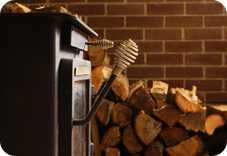Washington's Success
Tracking Program’s Radon Risk Map Prompts Testing, Protects Lives
![]()
Radon Risk High in Parts of Washington State
Radon is a gas that you cannot see, smell, or taste. According to the U.S. Environmental Protection Agency, radon causes about 20,000 cases of lung cancer each year, making it the second leading cause of lung cancer after smoking. Radon can seep up from the ground and become trapped in buildings. Testing is the only way to know if radon levels are high in a particular home or office. While some regions in Washington are known to have high risk for radon exposure, the EPA’s Map of Radon Zones for Washington identified those zones only at the county level.
Tracking Program Maps Show Radon Risks
The Washington Tracking Program worked with state geologists to develop a new, more detailed radon exposure risk map. This map identified areas of low, medium, and high risk of radon exposure based on soil and rock types. Tracking staff also gathered state-wide radon testing data from national testing companies as well as data from the state radon program. These data were used to produce maps that showed testing results by ZIP code. Tracking program staff developed a radon content area on the Washington tracking portal that included maps of radon test data and exposure risk. Layering these maps showed new, previously unknown hot spots, such as around the Puget Sound. It also showed many high to moderate risk areas where no testing had been performed in the past. Based on this new information, tracking program staff raised public awareness about the importance of radon testing through outreach to local public health officials, a news release, and Web and social media posts.
Radon Awareness Leads Tracking Employee to Test Her Own Home
Meghan works in the Washington Tracking Network program. While working on this project, she realized that the home she and her family recently moved into was in a high- risk area for radon and should be tested. Testing revealed an elevated radon level in a basement room her step-daughter had chosen as her bedroom. Acting on the test results, the family took the simple, recommended steps to mitigate the radon. Adding a fan and keeping the bedroom door open as much as possible to increase air circulation helped to lower the radon level and keep Meghan’s family safe.
“I’m so happy we discovered the high radon levels quickly and not after many years of exposing our children to them,” said Meghan.
Preventing Accidental Carbon Monoxide Deaths
![]()
What is the problem?
Accidental poisoning from carbon monoxide (CO) causes about five hundred deaths in the U.S. each year. In Washington, about 53 people go to the hospital for symptoms of CO poisoning every year. Many acute CO poisonings are from exposure to CO from fuel burning appliances, portable generators, or charcoal burners brought inside the home. A study of a CO poisoning outbreak in King County, during power outages in 2006, showed that 70% of people had been exposed to toxic levels of CO from generators or charcoal burners brought inside. In response to new state legislation, the Washington Building Code Council wrote draft rules in 2009 requiring the placement of CO alarms in homes. However, the draft rules applied only to homes with fuel-fired appliances or those with attached garages. As a result, many residents were still at a high risk for carbon monoxide poisoning.
What did Tracking do?
Washington Tracking Network scientists led an agency-wide Carbon Monoxide Poisoning Prevention Planning Workgroup. This workgroup coordinated Washington Department of Health actions with the work of the Washington Building Code Council. Washington Tracking Network staff provided data from their network to decision makers for these new rules. These data described not only Washington's burden of preventable deaths and sickness due to CO poisoning, but also the risks – such as indoor use of generators – that cause a large number of CO poisonings. This information helped policy-makers recognize the need to extend the building code rules to more types of homes.
Improved public health
The Washington Building Code Council approved a measure to extend the rule to many types of homes. Other organizations and health advocates successfully lobbied the state legislature for the CO poisoning prevention issue and creating more awareness about the new rules. The Washington Department of Health and Washington Tracking Network provided the facts needed to help craft the rule's language. The Washington Building Code Council now requires all residential buildings in Washington to have carbon monoxide alarms by 2013. The new, stricter rules provide greater protection of public's health.
Helping Communities Connect Air Pollution Control and Improved Health

What is the problem?
For American Indians and Alaska Natives in Washington, asthma rates are much higher than the state average. These cases are also less likely to be well controlled. Reducing asthma triggers is a key step in preventing asthma attacks. Smoke can trigger an asthma attack and non-certified wood burning stoves are a major source of smoke in some communities. However, persuading community leaders to address smoke from non-certified woodstoves can be very hard.
What did Tracking do?
The Washington Tracking Network partnered with the Asthma Program at the Department of Health to find out where wood burning stoves- especially non-certified stoves - were being used. The data showed that wood burning was common in many communities, but scientists were most concerned about the high use of non-certified stoves in tribal communities where asthma rates were also high. They met with tribal leaders about wood stove use and highlighted how indoor and outdoor smoke from wood stoves can trigger problems for people with asthma.
Improved public health
After seeing the data about wood stove use and how wood smoke can trigger asthma, tribal leaders began to mobilize and motivate stakeholders around their action plan for managing smoke in their communities.
Improved Public Health Surveillance and Action for Lead

What is the problem?
An outdated, paper-based system made lead test reporting inefficient in Washington. State and local health agencies also had no way to share information about lead poisoning investigations in a secure, electronic environment. Using fax machines, paper and phones made ensuring the privacy of lab reports difficult and led to delays in case follow-up.
What did Tracking do?
The Washington Tracking Network improved the flow of environmental public health data by helping to build Washington's electronic lab reporting system: Public Health Reporting of Electronic Data (PHRED). PHRED makes it easier to handle public health reports like blood lead testing. Once agency workers receive data from PHRED, they can transfer reports of concern into the Public Health Issues Management System (PHIMS). Within hours, local health officials can access PHIMS and carry out their investigations.
Improved public health
Systems like PHRED and PHIMS make public health surveillance and response faster. Labs can now report electronic lead poisoning test results more efficiently and securely. The state Child Blood Lead Registry receives more standardized and complete test results. Local public health officials now are alerted quickly to possible lead poisoning cases, cutting delays and saving costs during case investigations. PHIMS provides state and local health agencies an easy, secure way to communicate about ongoing investigations, also providing technical assistance more quickly, maintaining privacy, and improving public health response and prevention.
Washington's Grantee Profile
[PDF 436 KB]- Page last reviewed: January 3, 2014
- Page last updated: August 10, 2011
- Content source:


 ShareCompartir
ShareCompartir